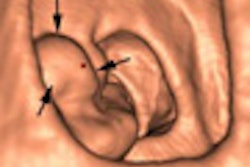A study detailed in a letter to the New England Journal of Medicine concludes that replacing ultrasound with CT for diagnosing appendicitis can significantly reduce the incidence of false-positive findings.
Owing to the potential seriousness of the condition, "surgeons have traditionally accepted up to a 20% rate of false-positive diagnosis of acute appendicitis in order to minimize morbidity associated with a missed diagnosis," noted Dr. Steven Raman and colleagues from the David Geffen School of Medicine at the University of California, Los Angeles, in their correspondence (NEJM, February 28, 2008, Vol. 358:9, pp. 972-973).
Yet the incidence of false positives remains as high as 42% in published studies, they noted. Many institutions, including the authors' own, have suggested that patient outcomes are better when a number of appropriate techniques, including CT, are used.
"However, several large-scale reviews of state databases have suggested no improvement in clinical outcomes in the era of presumably routine preoperative imaging for suspected acute appendicitis, and especially no decrease in the rates of false diagnosis of appendicitis or appendiceal perforation," they wrote. Their study aimed to address the uncertainty with regard to outcomes.
The researchers examined the use of preoperative imaging and clinical outcomes in 1,081 adults (616 men and 45 women, ages 16 to 90 years) who underwent surgery for suspected appendicitis between 1996 and 2006.
The core group of physicians, radiologists, and surgeons was fairly stable during the study period, although the surgery group was expanded, Raman and colleagues wrote.
During the 10-year study period, preoperative ultrasound was increasingly replaced by CT. The annual rate of preoperative CT use increased from 20% in 1996 to 85% in 2006 (p = 0.001), while the use of sonography decreased from 24% in 1996 to 9% in 2006 (p < 0.001), the group wrote. Over the same period, the rate of laparoscopic appendectomy use increased from 0% in 1996 to 6% in 2002, and finally to 23% in 2006.
"From 1996 to 2006, the overall rate of false-positive diagnosis of appendicitis among adults decreased significantly, from 24% to 3% (p = 0.001)," Raman and his team wrote. "There was a significant inverse relationship between the annual increase in the rate of CT use and the overall rate of false-positive diagnosis of appendicitis among adults (p < 0.001)." The overall rate of pathologically proven appendiceal perforation decreased significantly, from 18% in 1996 to 5% in 2006 (p < 0.001).
The data suggest that increased use of preoperative CT, when read by experienced radiologists, can improve clinical outcomes significantly. Facilities can expect sustained decreases in the rates of both false-positive appendicitis diagnosis and appendiceal perforation, they concluded.
By Eric Barnes
AuntMinnie.com staff writer
March 19, 2008
Related Reading
CT scans lower risk of unnecessary appendix surgery, February 29, 2008
Trauma radiologists overhaul abdominal CT contrast protocols, January 21, 2008
Multidetector-row CT accurately detects perforated appendicitis, January 4, 2008
Emergency bedside US may not rule out appendicitis, July 30, 2007
Negative appendectomy in pregnancy increases risk of fetal loss, November 25, 2007
Copyright © 2008 AuntMinnie.com




















